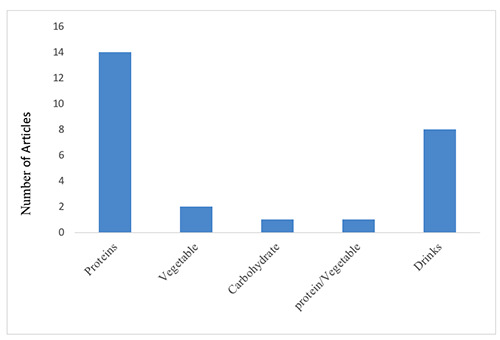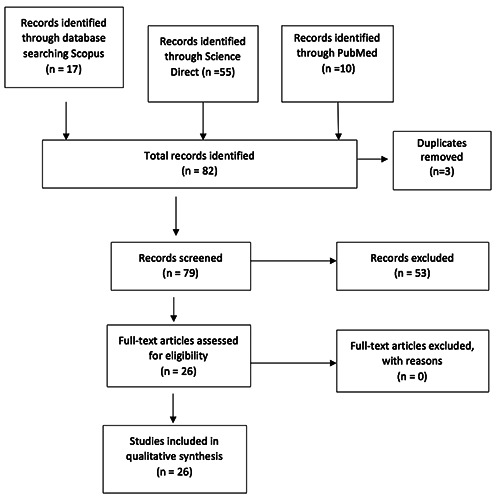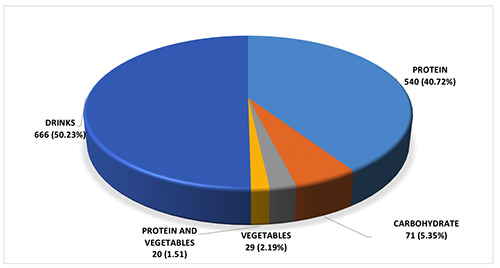尼日利亚与食品和饮料相关的多重耐药细菌流行情况(2015-2020年):一项系统综述
摘要
食物是人类接触耐抗生素细菌的重要载体,耐抗生素细菌是耐药基因的储存库,也是日益引起人们关注的食品安全问题。抗菌素耐药性,包括多药耐药(MDR),是一个日益严重的全球性问题,对人类健康构成严重关切。本研究旨在综合与尼日利亚境内销售的食品和饮料相关的耐多药细菌流行率的数据,以便对该领域的现有发现作出贡献。利用三个数据库对2015年至2020年尼日利亚与食品和饮料相关的多重耐药细菌流行情况进行了全面的文献检索;PubMed, Science Direct和Scopus。经过筛选和选择,从82篇文章中选取26篇进行定性数据综合。据报道,在所有26篇文章中分离出的总共1326种耐多药细菌中,包括水在内的饮料中观察到的患病率最高(660),而在蛋白质和蔬菜类食品中观察到的患病率最低(20)。埃希氏杆菌的出现频率最高,在26篇文章中有10篇以耐多药细菌的形式出现。在纳入本研究的26篇文章中,沙门氏菌以耐多药形式出现在7篇文章中,在所有报道的7篇文章中,沙门氏菌以耐多药细菌的形式出现的比例最高(85.4%)。公共卫生人员需要确保在食品和饮料的生产和处理过程中进行关键控制,并提高对适当卫生习惯的认识,以防止耐多药细菌的传播成为日益严重的食品安全问题(Zurfluh等人,2019;Mesbah et al., 2017;Campos et al., 2019)。食品可以通过不同的方式受到污染,包括接触灌溉水、粪便、粪便或带有致病菌的土壤。如果没有正确执行食品安全标准,食品也可能在收获、收获后处理或加工过程中受到污染(Meshbah等人,2017)。由耐药生物引起的食源性疾病是最重要的公共卫生问题之一,因为它们会增加食品生产链中产生抗生素耐药性的风险(Hehempour-Baltork等人,2019)。除了引起食源性疾病的致病菌外,未经加工或未按照标准程序加工的食品还可能向消费者引入几种耐抗生素细菌(Gekemidis等人,2018)。抗生素耐药性虽然存在于非致病性细菌中,但可能通过水平基因转移传播给其他物种,包括存在于环境中或食用受arb污染的食品后的机会性病原体。当食用受arb污染的食物时,抗生素耐药基因的传播可能会影响肠道微生物群,从而导致人类肠道中抗生素耐药基因(ARG)的增加(Gekemidis等人,2018)。耐多药细菌被定义为对三种或三种以上抗菌素类别中至少一种抗菌素具有耐药性的细菌(Sweeny等人,2018)。从人类食用的食物中分离出的病原体的耐药性有所增加,大肠杆菌和肠炎沙门氏菌被认为是最重要的病原体,因为它们能够影响耐药基因的人畜共患转移(Canton等人,2018;Maneilla-Becerra et al., 2019)。然而,其他病原体,如弧菌、某些种类的气单胞菌、F型肉毒梭菌孢子和弯曲杆菌,与食用海鲜或其他动物性食品的人类的食源性疾病有关(Maneilla-Becerra等人,2019)。与食品相关的其他一些耐药细菌包括金黄色葡萄球菌、李斯特菌和志贺氏菌(Maneilla-Becerra等人,2019)。因此,本研究旨在综合尼日利亚境内销售的食品和饮料相关耐多药细菌流行情况的数据(2015-2020年),以便为该领域的现有发现做出贡献。



Foods are essential vehicles in human exposure to antibiotic resistant bacteria which serve as reservoirs for resistance genes and a rising food safety concern. Antimicrobial resistance, including multidrug resistance (MDR), is an increasing problem globally and poses a serious concern to human health. This study was designed to synthesize data regarding the prevalence of MDR bacteria associated with foods and drinks sold within Nigeria in order to contribute to the existing findings in this area. A comprehensive literature search on the prevalence of multi-drug resistant bacteria associated with foods and drinks in Nigeria from 2015 to 2020 was conducted using three databases; PubMed, Science Direct and Scopus. After screening and selection, 26 out of 82 articles were used for the qualitative data synthesis. Of the total of one thousand three hundred and twenty-six MDR bacteria reportedly isolated in all twenty-six articles, the highest prevalence (660) was observed in drinks, including water, while the lowest (20) was observed in the article which combined results for both protein and vegetable-based foods. Escherichia sp. had the most frequency of occurrence, appearing as MDR bacteria in ten out of the twenty-six articles. Salmonella sp. appeared as MDR in seven out of the twenty-six articles included in this study, in all seven articles where it was reported, it had the highest percentage (85.4%) prevalence as MDR bacteria. Public health personnel need to ensure critical control during the production and handling of foods and drinks, as well as create more awareness on proper hygienic practices to combat the spread of MDR bacteria becoming a growing food safety issue (Zurfluh et al., 2019; Mesbah et al., 2017; Campos et al., 2019). Foods can be contaminated by different means, including exposure to irrigation water, manure, feces or soil with pathogenic bacteria. Foods can also become contaminated as they are harvested, handled after harvest or during processing if food safety standards are not correctly applied (Meshbah et al., 2017). Food-borne diseases caused by resistant organisms are one of the most important public health problems as they contribute to the risk of development of antibiotic resistance in the food production chain (Hehempour-Baltork et al., 2019). Apart from pathogenic bacteria causing foodborne diseases, foods that are raw or not processed following standard procedures can introduce several antibiotic-resistant bacteria (ARB) to consumers (Gekemidis et al., 2018). Antibiotic resistance, though harbored in non-pathogenic bacteria, can potentially be spread through horizontal gene transfer to other species including opportunistic pathogens that are present in the environment or after consumption of ARB-contaminated foods. When ARB-contaminated foods are consumed, the spread of antibiotic resistant genes may affect the gut microbiome thereby contributing to the pool of antibiotic-resistance genes (ARG) in the human gut (Gekemidis et al, 2018). MDR bacteria have been defined as bacteria that are resistant to at least one antimicrobial agent present in three or more antimicrobial classes (Sweeny et al., 2018). There has been an increase in drug resistance in pathogens isolated from food for human consumption with species of Escherichia coli and Salmonella enterica being considered among the most important pathogens due to their ability to effect zoonotic transfer of resistant genes (Canton et al., 2018; Maneilla-Becerra et al., 2019). However, other pathogens, such as Vibrio spp., some species of Aeromonas, spores of Clostridium botulinum type F, and Campylobacter, have been linked to food-borne diseases in humans who have consumed seafood or other animal foods (Maneilla-Becerra et al., 2019). Some other resistant bacteria associated with foods include Staphylococcus aureus, Listeria spp., and Shigella spp. (Maneilla-Becerra et al., 2019) This study was therefore designed to synthesize data (2015-2020) regarding the prevalence of MDR bacteria associated with foods and drinks sold within Nigeria in order to contribute to the existing findings in this area.

 求助内容:
求助内容: 应助结果提醒方式:
应助结果提醒方式:


